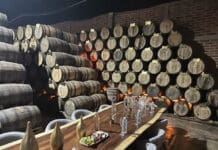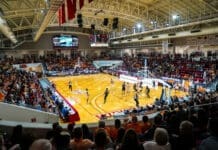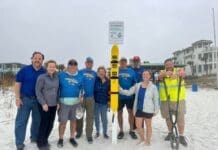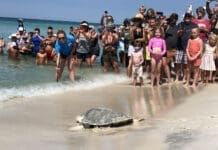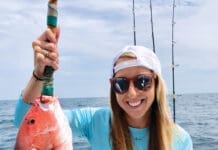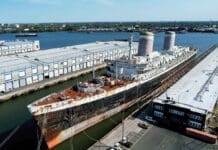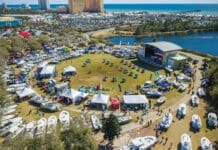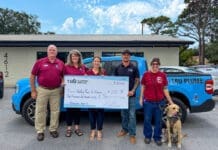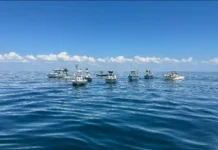By Will Estell
Soaring by on a high-speed pass, barely one hundred feet above the runway—at a speed I’m told at the time is in excess of 700 mph—I can literally smell the fuel and feel the jet wash, before I hear the powerful roar of the F/A -18 Super Hornet as it soars by then climbs steeply just ahead of us, disappearing into the clouds, before diving back down in a corkscrew then leveling out about a mile away. All of this happens in about 20 seconds before another pilot with cojones of steel, and the skills to match, flies by completely inverted, slightly further away, but still close enough to feel the change in the atmosphere from where I am standing on the tarmac.
What I am witnessing up close and personal today is the same magical breath of patriotism that fans see at airshows all over this great country each year. The only difference is, today I’m taking it all in from the Blue Angels communication cart, surrounded by a small team of just eight of the Blues support staff, along with my wingman for the day, Blue Angels Public Affairs Officer, Lt. Ben Bushong.
Since being established in 1946, the U.S. Navy Blue Angels hold the unique distinction of being the most well-known aerobatic team in the entire world. While they regularly wow crowds with breathtaking performances right here in our own backyard, their mission extends far beyond dazzling crowds at airshows, as they aim to inspire future generations of patriotic Americans, by demonstrating the unmatched aptitude, attitude and professionalism of the men and women serving in the U.S. armed forces.
These aero superstars do so much more than simply entertain with a breathtaking aerial showcase. Their performances represent thousands of hours of precision flight, discipline, unshakable resolve and the unwavering spirit of naval aviation. For decades, they’ve captivated millions with gravity-defying maneuvers, embodying the excellence and teamwork that define the U.S. Navy Blue Angels—or as we affectionally refer to them along these beautiful coastal communities of Northwest Florida, The Blues.
I had the opportunity to spend a day inside the world of The Blues, guided by LT. Bushong, and gained some firsthand insight into their headquarters at NAS Pensacola. Including observing a morning flight meeting, pre-flight preparations, and the behind-the-scenes maintenance and logistics performed by their team of 158 active-duty Sailors and Marines, that keep this elite squadron at peak performance.
Here are some Q&As from my behind-the-scenes day with LT. Ben Bushong and the Blue Angels team, part of a multi-publication media experience with The Blues:
What is the age range of the pilots and does age play a part in the selection process?
The age of our pilots usually range from early 30s to late 40s. Age isn’t necessarily a factor when applying for the team. All pilots need to have a minimum number of flight hours and experience to be able to apply.
As popular as the Blue Angels are around the country, how do you and your team feel about the escalation of attention after last year’s hit Amazon original, The Blue Angels?
The film definitely gives viewers an inside look into what it means to be a part of the U.S. Navy’s flight demonstration squadron, and it does it for an entire show season, including the selection process and intense training that the pilots endure to get to where they are. As a team we’re happy about the depiction and think the movie can only help bring our fans closer and hopefully create more interest in our mission.
Do the pilots still get any sense of nervousness when they fly or is it such a well-oiled repetitive motion, due to all the practice and shows, that it becomes like driving your vehicle from home to work and back?
Everything we do is based on safety and having absolute complete trust in one another. We absolutely all have to count on that up there and on the ground. So, during winter training, we incorporate the crawl, walk, run mentality to continue to work towards the tight formations. As a team, we are always chasing perfection, 100% of the time.
What criteria would you say does play the largest part in the pilot and support team selection?
With all team members, trust and personality are two big factors when selecting new team members. If your current command is letting you apply for this team, then that means you have already checked all the boxes on paper for the prerequisites. But we are looking for people who would make great ambassadors for the Navy and Marine Corps, and someone that you would potentially spend 300 days on the road with in a given season. Our Maintainers and Crew Chiefs perform all the preflight inspections on every aircraft, so the pilots can strap in and go! It takes complete trust in a person, to be able to strap in and fly without performing your own preflight inspection of the aircraft. We are a successful team. because everybody has complete trust that the person next to you is doing their job effectively and efficiently.
With such vicious schedules between practices, social and event obligations, and traveling 300 days per year, how much sleep does the average pilot get?
Wait…we’re supposed to be sleeping too? [laughs] Thursday morning we fly to our show site. The first flight at every city is our “circles” flight, where we fly over the airfield to find all the checkpoints for the show. Followed by a practice. Thursdays are typically the longest, because it’s a three-flight day: Transit, Checkpoint Flight and Practice. Friday we perform community outreach, visiting local schools and hospitals, then perform a full practice. Saturday and Sunday are show days, then we transit back to Pensacola after the show. Monday our team gets our day off, then it’s back to Tuesday and Wednesday practices here in Pensacola. Actually, not getting enough sleep is never really too much of a factor. We always perform in the afternoons, so there’s typically not many early mornings on the road.
Any other closing insight you and the team would like readers to know about the mission you all are fulfilling?
The Blue Angels are direct representatives of the 800,000 men and women serving in the Navy and Marine Corps. All of us are from the fleet and will return to the fleet after our time here. By design, our Navy and Marine Corps is expeditionary in nature, meaning all our operations are happening overseas and out of sight. The Blue Angels were designed to showcase the teamwork and professionalism of the U.S. Navy and Marine Corps to the American public, and like we always say, “We’re glad to be here!”
Will Estell is a seasoned writer, editor, and media entrepreneur with over 700 published articles spanning regional and national publications. His work covers coastal tourism, real estate, dining, automotive reviews, and celebrity interviews, earning him a strong reputation in Northwest Florida media. Currently the Chief Creative Officer of Estell Hussey Media, LLC, Will has co-founded 12 magazine titles and served as editor-in-chief for several others. Originally from Booneville, Miss., Will is a father of three and lives in Destin and Navarre with his wife, ABC 3 news anchor Laura Hussey-Estell.







